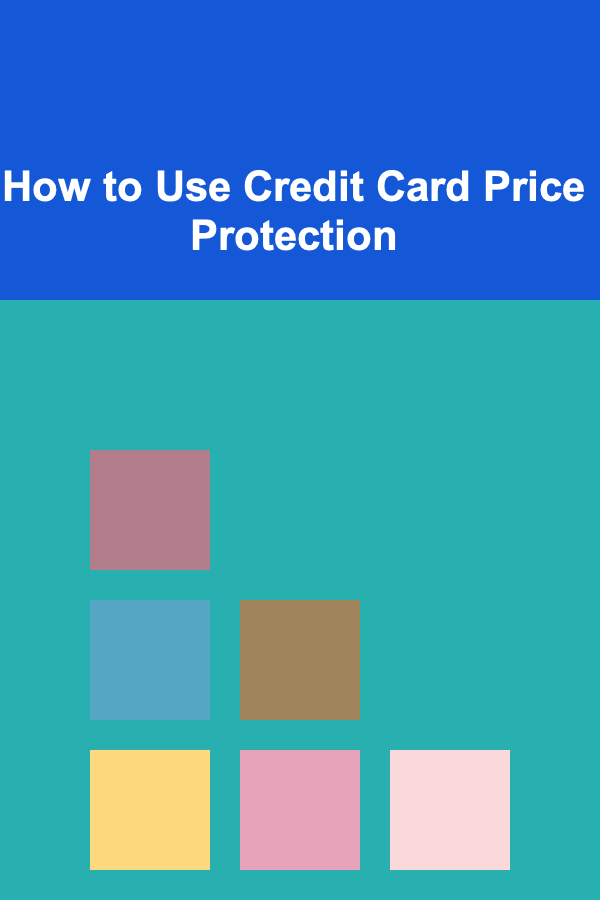
How to Use Credit Card Price Protection
ebook include PDF & Audio bundle (Micro Guide)
$12.99$10.99
Limited Time Offer! Order within the next:

Credit card price protection is one of the many underutilized benefits offered by credit card companies. It provides consumers with a safety net in case they find a lower price for an item they've purchased with their credit card. Understanding how to use credit card price protection can save you money, enhance your buying experience, and ensure you're getting the best deal possible after making a purchase. In this article, we'll cover everything you need to know about credit card price protection, including how it works, how to claim it, and best practices to maximize its benefits.
What Is Credit Card Price Protection?
Credit card price protection is a benefit that some credit cards offer to their cardholders. It ensures that if the price of an item you bought drops within a specified time period after your purchase (typically 30 to 60 days), you can be reimbursed the difference. This feature can be particularly useful for consumers who make big-ticket purchases or regularly shop online, where prices can fluctuate quickly.
While not all credit cards offer price protection, those that do often provide it as a part of their rewards or premium benefits packages. If you're planning to make a large purchase or simply want to ensure you're getting the best deal, understanding how price protection works is crucial.
How Does Credit Card Price Protection Work?
The mechanics of credit card price protection vary from one issuer to another, but the general process is quite similar. Here's a step-by-step breakdown of how it typically works:
2.1 Make an Eligible Purchase
To qualify for price protection, the item you purchase must be bought with an eligible credit card that offers this benefit. Additionally, the item must meet the following criteria:
- The item must be a tangible, physical product (price protection usually does not apply to services, gift cards, or digital goods).
- The purchase must be made using the credit card that provides the price protection benefit.
- The product must be available from the same retailer that you purchased it from. If you find the lower price on a different retailer's website, price protection may not apply.
2.2 Track Price Drops
Once you've made the purchase, the next step is tracking the price. Most credit card price protection policies will offer a specific time window in which the price drop must occur, typically within 30 to 60 days after the purchase date. During this period, if the price of the product drops, you may be eligible for a refund on the difference.
2.3 Submit a Claim
If you find a lower price for the item you purchased, the next step is to submit a claim to your credit card issuer. Here's a general outline of the claims process:
- Locate the product: You'll need to provide proof of the lower price, which typically means finding the same product at the same retailer or another retailer at a cheaper price. Many credit card companies will require screenshots of the lower price as evidence.
- Fill out the claim form: Most issuers have a claim form that you must submit online or via mail. This form will ask for your purchase details, including the product name, the date of purchase, and the price at which you bought it. Be sure to have the original receipt and the lower price proof.
- Wait for approval: Once you've submitted your claim, the issuer will review it and, if approved, issue a refund for the price difference. Some credit card companies may place a cap on how much you can be reimbursed, such as a maximum dollar amount per item or a total amount for all claims during the benefit period.
2.4 Receive Your Reimbursement
Once your claim is approved, your credit card issuer will either credit your account with the price difference or issue you a check. The timeline for reimbursement varies depending on the issuer but can range from a few weeks to a couple of months. Be sure to keep track of the status of your claim by following up with your credit card issuer if necessary.
Key Features of Credit Card Price Protection
Although the basic process for price protection is similar across issuers, there are some specific features you should be aware of before relying on this benefit.
3.1 Time Limit for Price Drops
Most credit card companies offer price protection for a specific period after the purchase date, typically between 30 and 60 days. During this period, if the price drops, you may be eligible for a reimbursement. Be sure to check the terms of your credit card to know exactly how much time you have to find a lower price and file a claim.
3.2 Eligibility of Products
Not all products are eligible for price protection. Common exclusions include:
- Services: Price protection typically only applies to physical goods.
- Used or open-box items: Many credit card companies will not reimburse price differences on items that are used, refurbished, or purchased from discount stores.
- Gift cards or memberships: These are generally excluded from price protection benefits.
- Sale prices: Items that are marked down or on clearance may not be eligible for price protection.
3.3 Reimbursement Limits
Credit card price protection benefits often come with reimbursement caps. For example, you might be eligible for up to $500 in price protection per item, with a total cap of $2,500 per year. Be sure to review the terms and conditions of your credit card to understand the maximum reimbursement amounts.
3.4 Price Comparison Sources
Your credit card issuer may have specific rules about how to prove the price drop. Some companies may only accept price comparisons from certain sources, such as the retailer's website or a major online marketplace like Amazon. Others may accept a wider range of price proof sources, including ads, flyers, or other online listings.
3.5 Administrative Fees
In some cases, there may be small administrative fees associated with submitting a price protection claim. These fees are usually minimal but could reduce the amount of your reimbursement, so it's essential to keep that in mind when claiming.
Tips for Maximizing Your Credit Card Price Protection
To make the most out of your credit card price protection, here are some tips you can follow:
4.1 Track Price Changes Actively
If you plan to make a significant purchase, consider setting up price drop alerts for the item. Many online shopping platforms like Amazon, Best Buy, or other retailers allow you to track price fluctuations for specific products. Using tools like Google Shopping, Honey, or CamelCamelCamel (for Amazon items) can help you stay on top of price drops and take advantage of price protection when the time comes.
4.2 Keep All Documentation
When you make a purchase, always keep a copy of your receipt and any other documentation proving the original purchase price. This documentation will be required when submitting a claim. Additionally, keep track of the price change with screenshots, online ads, or other verifiable evidence to support your claim.
4.3 Be Aware of Exclusion Criteria
Before making a purchase, double-check the terms and conditions of your credit card's price protection benefit to understand what is and isn't covered. By familiarizing yourself with the exclusions, you can avoid disappointment later if you're unable to file a claim.
4.4 Use Price Protection for Major Purchases
While price protection benefits may seem like a small perk, they can be particularly useful for large-ticket items. If you're purchasing expensive electronics, furniture, or appliances, price protection can be an excellent way to ensure that you're not overpaying for your purchase. For example, if you buy a new laptop for $1,500 and find that the price drops to $1,200 within the next month, you could get a refund of $300---essentially reducing your purchase cost.
4.5 Stay Within the Timeframe
It's crucial to act quickly when a price drop occurs. Don't wait until the final days of the protection period to check for price reductions. If you miss the window for a price claim, you may lose out on the potential reimbursement.
Alternatives to Credit Card Price Protection
While credit card price protection is a valuable benefit, it's not always the best solution for every shopper. Here are some alternatives to consider if price protection isn't available on your card:
5.1 Price Matching Policies
Many retailers offer their own price matching policies, which can be a viable alternative to credit card price protection. If you find a lower price at a competitor store, some retailers will match or even beat that price. Be sure to inquire about the store's price match policy before making your purchase.
5.2 Refund or Return Policies
Some stores allow you to return an item for a refund if the price drops shortly after purchase. This is especially common for high-end electronics and large appliances. Make sure you're aware of the store's return policy and whether price drops will influence your ability to return or exchange an item.
5.3 Shopping Apps and Browser Extensions
Using shopping apps like Honey, Rakuten, or browser extensions like PriceBlink can help you automatically track prices across multiple retailers and notify you when a price drop occurs. These tools can give you peace of mind and help you secure the best possible deal.
Conclusion
Credit card price protection is a powerful benefit that can help you save money on your purchases. By understanding how it works, being aware of the terms and conditions, and actively tracking prices, you can take full advantage of this feature. Whether you're making a big-ticket purchase or simply want to ensure you're getting the best price, credit card price protection offers a valuable safety net to maximize your spending power.

How to Profit from Deep Learning Models in the Freelance World
Read More
How to Tidy Up Your Home in 30 Minutes or Less
Read More
How To Water Your Garden Efficiently
Read More
How to Plan a Multi-Day Thru-Hike
Read More
How to Develop Basic Cooking Skills: A Comprehensive Guide
Read More
10 Tips for Budgeting After a Job Loss
Read MoreOther Products

How to Profit from Deep Learning Models in the Freelance World
Read More
How to Tidy Up Your Home in 30 Minutes or Less
Read More
How To Water Your Garden Efficiently
Read More
How to Plan a Multi-Day Thru-Hike
Read More
How to Develop Basic Cooking Skills: A Comprehensive Guide
Read More